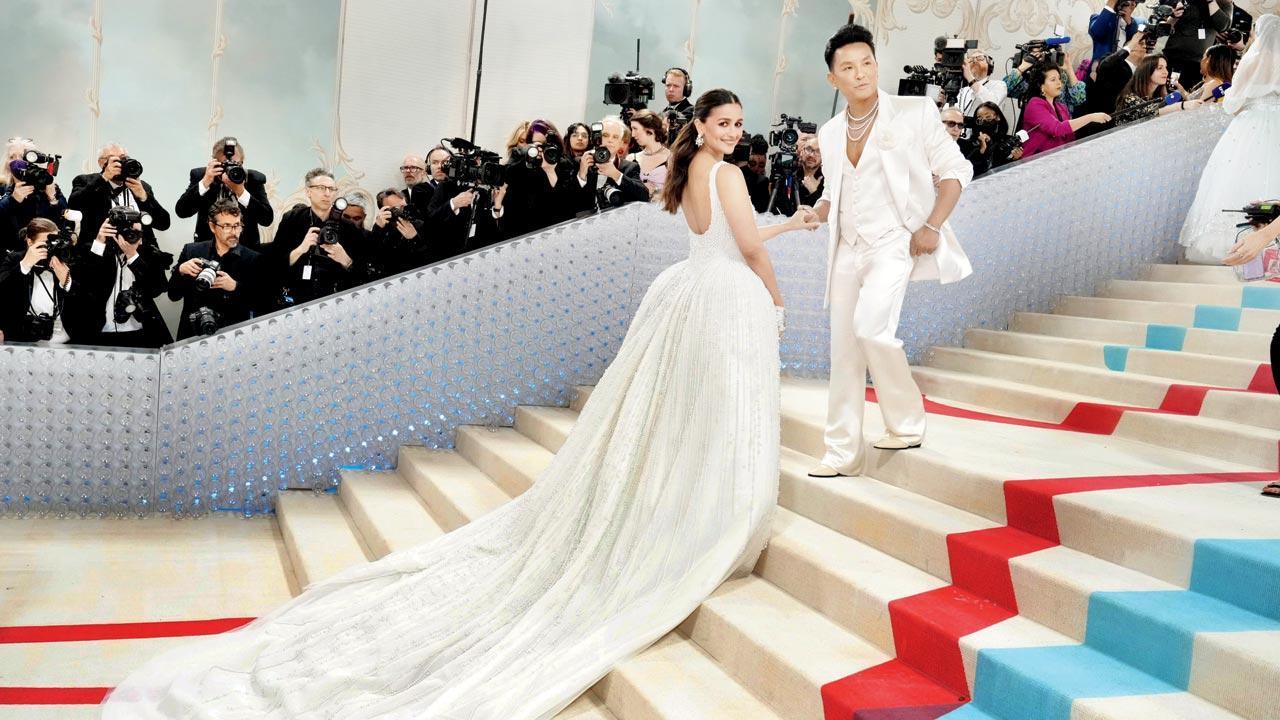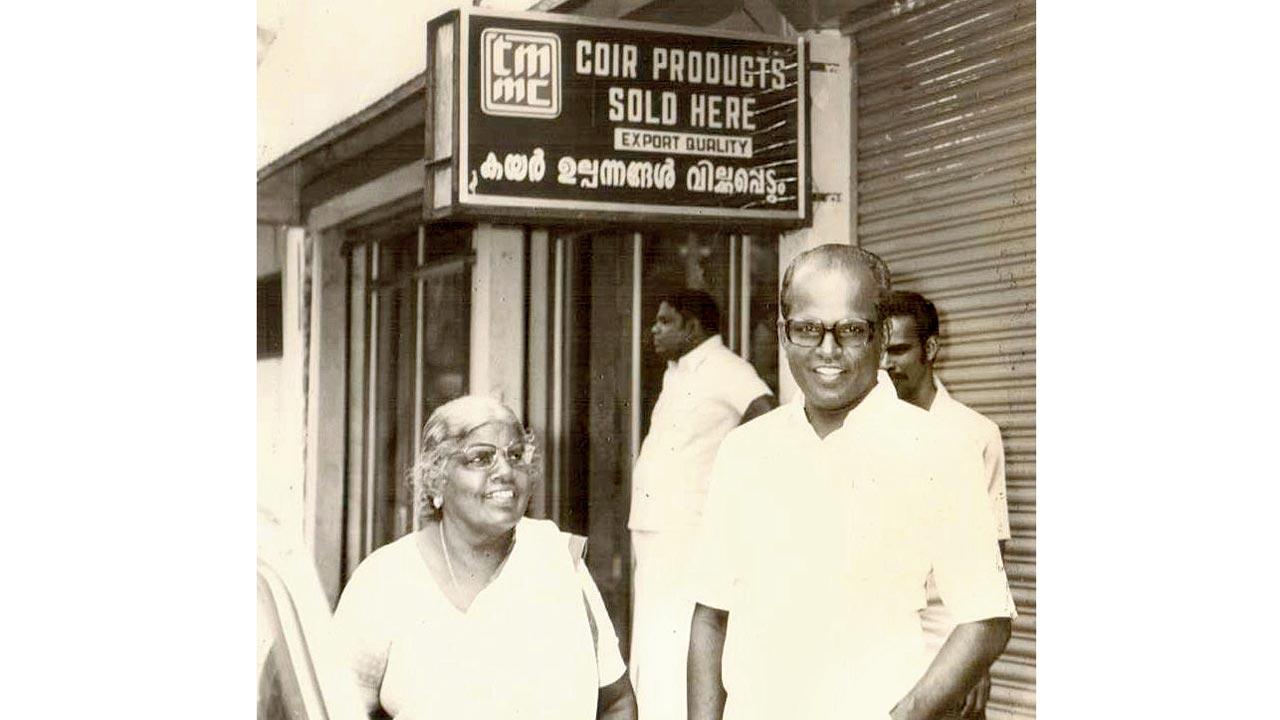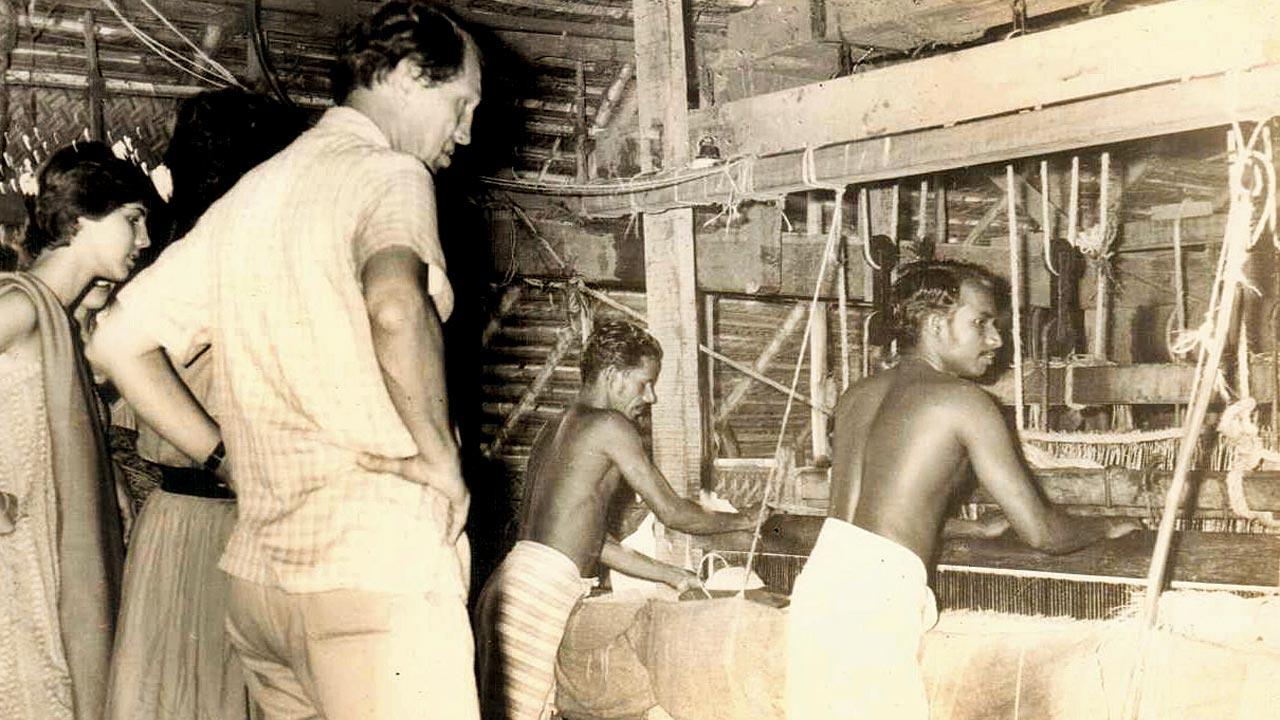Behind the viral Met Gala sisal fibre carpet is a family in Alleppey challenging the carpet belt’s supremacy with a century-old legacy that wants you to look south

Alia Bhatt and designer Prabal Gurang walk the now-famous carpet at the 2023 Met Gala celebrating Karl Lagerfeld: A Line Of Beauty at The Metropolitan Museum of Art on May 1 in New York City. Pics/Getty Images
Doja Cat responded to all questions with a meow. Alia Bhatt wore a one-lakh pearl studded gown at her Met Gala 2023 debut that we thought was too safe for its legacy. And Jared Leto, who posed in an oversized mascot version of Karl Lagerfeld’s much-loved cat Choupette, grabbed eyeballs on the red carpet. But wait, this year’s carpet wasn’t red. It was beige with red and blue swirling lines painted by designers in America. Not wool, it was sisal. Not firang, it was made in Alleppey.
The ground that the celebrities stood on, posing for the photographers to click them at what is the world’s biggest annual fashion extravaganza, has become as famous as them. When last did a carpet go viral?
ADVERTISEMENT
 Unlike the Oscars, the Met Gala didn’t always have a red carpet experience. British fashion editor Hamish Bowles is seen walking up the concrete steps of the MMoA in 1998
Unlike the Oscars, the Met Gala didn’t always have a red carpet experience. British fashion editor Hamish Bowles is seen walking up the concrete steps of the MMoA in 1998
Sivan Santhosh and Nimisha Srinivas make up the team behind Neytt by Extraweave, a luxury design house with an 106-year-old hand-weaving history. The same bunch is behind last year’s Met Gala carpet, except that one was deep red with broad white and blue stripes. Having exported carpets to Restoration Hardware, Ralph Lauren Homes, Crate and Barrel, and IKEA, their firm, says Santhosh, 33, is known for quality natural fibre and sisal floor coverings. “This order came through an old customer in the US called Fiber Works,” he narrates, “who wanted us to collaborate on a project. It turned out to be for the Met Gala!”
“Ecstatic but nervous” is how he remembers feeling at the thought of being part of the annual fundraiser held for the benefit of the Metropolitan Museum of Art’s Costume Institute in New York City. He remembers the communication with the organising team as smooth since they were clear about the design and that this year, they’d move from wool to a natural fibre. “They were considering sisal [fibre from the bark of the agave plant], so we made a few samples, which they liked. That this year, it was beige, posed a challenge for us because we had to maintain uniformity of shade,” he says of the 58 rolls of 4x30m they supplied, covering almost 7,000 sq mt of the venue. The carpet weighed around 1,600 gm per sq mt and took 40 people to manufacture over 60 days. Equal in quality and tone across all 58 rolls, it was made from sisal sourced from Madagascar, where the “whitest and highest quality fibre” is available. Although machine made, Santhosh says that the piece had to go through hand-done processes, including fibre weighing and yarn conversion. After a carpet is woven, minor errors are usually rectified by skilled women workers who meticulously correct the knots. In this case, quality inspection included a tenacity test given that scores of visitors were likely to walk on it in stilettos. “The weave construct had to be very tight so that nobody would trip and fall.”
 While the Met Gala carpet was machine-made, several of the processes in its manufacture were hand done, including correcting of knots usually done by skilled women workers
While the Met Gala carpet was machine-made, several of the processes in its manufacture were hand done, including correcting of knots usually done by skilled women workers
The rolls were shipped to New York three months prior for local artists to paint. Over the last few days, Internet users have compared the carpet’s red and blue lines to the TikTok logo. “I wasn’t expecting that!” muses Santhosh, “but the use of colour was very specific to Karl [Lagerfeld] and what inspired him. The serpentine lines seem to be inspired by English Painter William Hogarth [Line of Beauty], so it seems like they wanted to experiment with line movement to make it attention grabbing and livelier.”
While for 62 years, the Oscars has had a carpet in an exclusive shade called Academy Red—made by Signature Systems Group since 2008—until they changed it to champagne this year, the 1948-born Met Gala did not have a carpet at all. As recently as 1998, celebrities climbed the concrete steps of the museum. They gradually moved to a carpeted stair tread, and full carpeted steps after. But in 2016, the design changed from the traditional red to the Manus x Machina theme, featuring a cream rug with red and pink colour-blocking. The 2017 carpet celebrated the work of Comme des Garçons through a minimalist white rug with
cobalt-blue borders.
 Santhosh’s grandmother, Kalyani Velayudhan with her oldest son, Pavithran, who is 90 and still in the business. This photograph dates back to the late 1970s and was taken outside of the small shops they had in Cherthala, Alleppey, where the 106-year-old business is still located
Santhosh’s grandmother, Kalyani Velayudhan with her oldest son, Pavithran, who is 90 and still in the business. This photograph dates back to the late 1970s and was taken outside of the small shops they had in Cherthala, Alleppey, where the 106-year-old business is still located
This year, it wasn’t just the carpet that changed. The green hedges separating the press and attendees were replaced by a wall of recycled plastic bottles.
Following the same theme of sustainability, Neytt has consistently experimented with newer natural fibres. While Santhosh’s grandfather, Sri Velayudhan launched the business in 1917 as a coir manufacturer because coir was abundantly available in Kerala, it was his father, Santhosh Velayudhan who started a B2B business vertical that worked with companies from outside India.
In 2012, they also supplied a rug to the White House. “This was my grandmother’s father’s business, which my grandfather [her husband] took over,” says Santhosh. The business was headquartered in Cherthala, Alleppey. “Initially,” recalls Santhosh, “the carpets were all handmade by local artisans. But in the 1990s, we started importing machines from Belgium, France, and Spain.” The company started by making coir mats, which they sold locally, slowly expanding the business, mainly the US. “Back then, there was no way to contact people. One would send letters and wait for days on end, hoping to get a response on the orders,” he adds. “Though my grandfather ran the business, my grandmother took care of every day operations, including sourcing the coconuts from the trees in our farm.”
 Until the 1990s, they did not use machinery and used handloom weaving techniques to make coir carpets. After the death of Santhosh’s grandfather in 1957, the business was run by his uncles, Prasad and Pavithran. In 1982, his father, Santhosh Velayudhan, joined the company
Until the 1990s, they did not use machinery and used handloom weaving techniques to make coir carpets. After the death of Santhosh’s grandfather in 1957, the business was run by his uncles, Prasad and Pavithran. In 1982, his father, Santhosh Velayudhan, joined the company
The luxury carpet manufacturing hubs in India are situated in Kashmir and Mirzapur in Uttar Pradesh. “We wanted to change this,” Santhosh tells mid-day. “South India was never known for luxury carpet making. Motifs and design elements associated with southern India are not easily appreciated. We are working on that.”
The collection inspired by the Aranmula Kannadi, an ancient mirror-making craft that involves creating mirrors that produce distortion-free images thanks to
the secret alloy metal combination, is one example. Another collection is based on Vallamkali, the famous boat race held in Kerala.
An India-made carpet winning acclaim overseas isn’t new.
 Jasmine Roy; (right) Sivan Santhosh and Nimisha Srinivas of Neytt by Extraweave
Jasmine Roy; (right) Sivan Santhosh and Nimisha Srinivas of Neytt by Extraweave
India’s handmade carpet heritage, records say, dates back to the 985 CE when Mahabalipuram was one of the oldest production centres. But, it was thanks to Mughal patronage in the 16th century, especially under Akbar, that farrashkhanas or workshops began to produce world class hand-knotted carpets inspired by Persian traditions and made by skilled artisans from Iran and Central Asia. During the 1600s, the East India Company is said to have engaged in exporting carpets.
An increase in trade during colonial rule with Europe meant that indigenous carpets were in demand. “India’s carpet design borrowed heavily from Persia,” says Jasmine Roy, vice president—design and business, Obeetee. The company which dates back to 1920 was started in Mirzapur by Britishers FH Oakley, FH Bowden and JAL Taylor.
“Persian carpets were known to have a narrative and would reflect everyday life and every motif had a symbolic meaning, including hunting scenes, flora and fauna.”
In the late 19th century, “jail carpets” began to get famous. Convicts in Agra and the jails in Deccan were taught the art of carpet making. “Their designs,” says Roy, “had lattices. It was a psychological effect of viewing the world through the bars of the jail.” These designs are now prized possessions and housed in museums across the world.
 Subscribe today by clicking the link and stay updated with the latest news!" Click here!
Subscribe today by clicking the link and stay updated with the latest news!" Click here!







